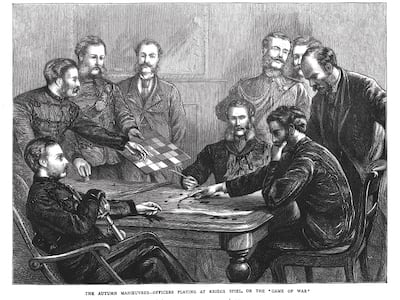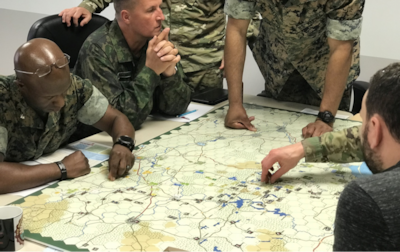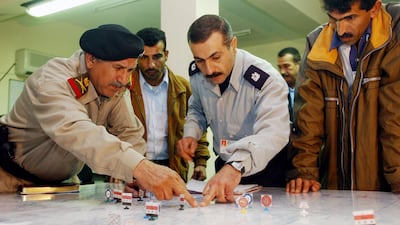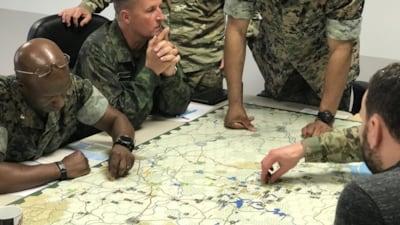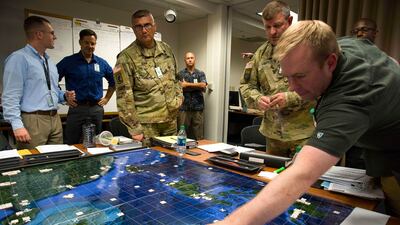On February 3, US General Mark Milley — the highest-ranking officer in the US military — issued a warning that Ukraine would be over-run in 72 hours in the event of a Russian invasion.
The US had strong intelligence on Russia’s intentions, but some of Gen Milley’s prediction was informed by Pentagon-sponsored war games, many of which he had been involved in during the run-up to war.
Some of these 'games' are expensive computer simulations. However, others are literally games, played with dice, playing boards and counters, sometimes augmented by computers and expert adjudicators, to identify weaknesses in future conflicts and train officers.
In the past 200 years, some of these war games have helped change the fate of nations, from the fall of France in the Second World War to the 1991 Gulf War and quite possibly, the ongoing war in Ukraine.
The origins of war games
The practice goes back to the early 19th century and the work of a Prussian officer, Lieutenant Georg von Reiswitz, who convinced his seniors that war could be re-created on a map, using red and blue counters for opposing forces, rules and dice.
“War games are well-understood models that integrate terrain, forces, weapons, space and time, and they are invaluable to turn knowledge into understanding,” says John Curry, a senior lecturer at Bath University, specialising in games development, who has worked with the UK Ministry of Defence and the Pentagon on war-gaming.
“Operational analysis gives us clear guidelines on rates of advance, daily casualties, the effectiveness of armour in towns,” he says, referring to analysis that models these aspects of war using historical and contemporary data.
That data can then become the basis of a game.
Cheaper than holding full-scale military exercises, war-gaming soon became commonplace by the turn of the 20th century in officer-training schools across Europe, the US and Japan, where the practice was introduced by German advisers.
War games have sometimes been spookily accurate in predicting outcomes but for many, their main role is not prediction, but training.
“There is a strong interest from the military to use war-gaming as part of their curriculum due to both cost and flexibility,” says David Freer, chief executive of commercial war-gaming company, Wargame Design Studio.
Mr Freer’s company produces games designed by the late John Tiller, who worked on 20 gaming and simulation projects for the US Air Force and Navy.
“The ability to use it as a learning tool, as well as putting students into interactive roles that can be networked and repeated, are all positives,” Mr Freer says.
Mr Freer’s work is at the point where the military use of war-gaming and the civilian hobby side of the pursuit overlap.
This overlap came to light with striking speed in 1990, when Saddam Hussein’s army invaded Kuwait.
On August 2, 1990, former Pentagon employee Mark Herman was pulled away from his day job —designing war games — to help planners understand the crisis.
Herman had designed a detailed game called Gulf Strike, which provided a rough, but ready-made recreation of US, Saudi Arabian and Iraqi forces in the Middle East.
Defence department staff hurriedly modified the game using classified information and through August, used Gulf Strike to plan the war.
By August 3, initial games suggested that Saddam Hussein had next to no options for victory, although a powerful computer simulation, TACWAR, would assist with the finer details of planning.
Predicting the future
The Prussian mastery of the games would carry over to the German army of the interwar years and later, Hitler’s military.
The Nazis used it to terrifying effect planning the invasion of France, holding multiple “map exercises” using counters before the invasion.
But like any activity that can influence the course of a war, the information war games produces might not be listened to by policymakers.
The Nazis’ experience with war-gaming illustrated the latter issue when they invaded Russia in 1941.
German war games highlighted a major flaw in the Nazis’ logistical capability: getting supplies for a four million-strong invasion force deep within Russia.
Eager to keep Hitler happy, senior German commanders simply ignored the game results, with disastrous consequences.
Twenty-three years later, the US conducted a war game with dozens of participants working through the Vietnam crisis.
That game, Sigma II-64, predicted that heavy US bombing of Communists in Vietnam would not guarantee victory.
The game showed that a large US ground force would be needed, which could spark American public opposition to the war — eventualities that came to pass.
Peter Perla, a war-game designer at the Centre for Naval Analysis and author of The Art of Wargaming: A guide for professionals and hobbyists stresses the problem here is the “openness of decision-makers to taking aboard the insights provided by the games, not merely their overall results, and using them to inform, rather than dictate, their subsequent decisions.”
This process has worked spectacularly in the past: in around 300 war games before the Second World War, the US Naval War College helped inform the future size, capabilities and strategies needed in a major war.
US Admiral Chester Nimitz would later say the games were essential for planning victory against Japan.
“Because war games often look at future possibilities, they can sometimes prove prescient,” Mr Perla says.
“The problem, of course, is that what gets reported are those occasions when a game got something right. Less reported are those occasions when they got it wrong. What tends to be forgotten, for example, is that a lot of the Naval War College interwar games ‘predicted’ things that did not occur in the war,” he says.
Milan Vego, a professor at the US Naval War College, also cautions that games should not be seen as a crystal ball.
“The Germans used the games to familiarise the players with a future theatre of conflict. But more important for them was to have a number of scenarios and the idea was that the more scenarios you play, some of them will resemble a real situation,” he says.
“You cannot predict, nobody knows what will happen.”
Mr Perla says that the games are useful guides to what might happen in real conflict.
“My simple bottom line is that war games do not predict, but war-gamers do. By which I mean that a war game can contribute to the predictive capability of those who participate and study the problem it addresses,” he says.
War-gaming Ukraine
The idea that war games are not for prediction may go some way to explaining why US-sponsored war games have frequently shown former Soviet states suffering swift defeat against Vladimir Putin's Russia, as Gen Milley feared.
Before the war, several games, some classified, others reported in the media, saw Ukraine and Baltic states quickly overrun by Russian forces, even with Nato units in place.
Sebastian Bae, a colleague of Mr Perla, has argued that winning these games is not the point, stressing the importance of playing to understand future conflict dynamics.
For Mr Curry, the games that featured overbearing Russian might are still a problem, and game designers should go back to the drawing board.
“Analysts prior to the war were describing the war in narrative terms [a story] rather than using war games based on known military history. Anyone, including me, who designed a war game prior to the war would have said that the idea of the war being over in 15 days was ridiculous, unless Ukraine suffered a national failure of morale and the state collapsed,” he says.
“The Russian logistics were insufficient to support an opposed advance (ie the Russians have to manoeuvre and shoot at active opposition). Anyone designing a war game would realise these realities before they ever started putting counters on the map,” he says.
Anti-semitic attacks
The annual report by the Community Security Trust, which advises the Jewish community on security , warned on Thursday that anti-Semitic incidents in Britain had reached a record high.
It found there had been 2,255 anti-Semitic incidents reported in 2021, a rise of 34 per cent from the previous year.
The report detailed the convictions of a number of people for anti-Semitic crimes, including one man who was jailed for setting up a neo-Nazi group which had encouraged “the eradication of Jewish people” and another who had posted anti-Semitic homemade videos on social media.
Our family matters legal consultant
Name: Hassan Mohsen Elhais
Position: legal consultant with Al Rowaad Advocates and Legal Consultants.
COMPANY%20PROFILE
%3Cp%3E%3Cstrong%3ECompany%20name%3A%3C%2Fstrong%3E%203S%20Money%3Cbr%3E%3Cstrong%3EStarted%3A%3C%2Fstrong%3E%202018%3Cbr%3E%3Cstrong%3EBased%3A%3C%2Fstrong%3E%20London%3Cbr%3E%3Cstrong%3EFounders%3A%3C%2Fstrong%3E%20Ivan%20Zhiznevsky%2C%20Eugene%20Dugaev%20and%20Andrei%20Dikouchine%3Cbr%3E%3Cstrong%3ESector%3A%3C%2Fstrong%3E%20FinTech%3Cbr%3E%3Cstrong%3EInvestment%20stage%3A%3C%2Fstrong%3E%20%245.6%20million%20raised%20in%20total%3C%2Fp%3E%0A
ABU%20DHABI'S%20KEY%20TOURISM%20GOALS%3A%20BY%20THE%20NUMBERS
%3Cp%3EBy%202030%2C%20Abu%20Dhabi%20aims%20to%20achieve%3A%3C%2Fp%3E%0A%3Cp%3E%3Cstrong%3E%E2%80%A2%2039.3%20million%20visitors%2C%3C%2Fstrong%3E%20nearly%2064%25%20up%20from%202023%3C%2Fp%3E%0A%3Cp%3E%3Cstrong%3E%E2%80%A2%20Dh90%20billion%20contribution%20to%20GDP%2C%3C%2Fstrong%3E%20about%2084%25%20more%20than%20Dh49%20billion%20in%202023%3C%2Fp%3E%0A%3Cp%3E%3Cstrong%3E%E2%80%A2%20178%2C000%20new%20jobs%2C%3C%2Fstrong%3E%20bringing%20the%20total%20to%20about%20366%2C000%3C%2Fp%3E%0A%3Cp%3E%3Cstrong%3E%E2%80%A2%2052%2C000%20hotel%20rooms%2C%3C%2Fstrong%3E%20up%2053%25%20from%2034%2C000%20in%202023%3C%2Fp%3E%0A%3Cp%3E%3Cstrong%3E%E2%80%A2%207.2%20million%20international%20visitors%2C%3C%2Fstrong%3E%20almost%2090%25%20higher%20compared%20to%202023's%203.8%20million%3C%2Fp%3E%0A%3Cp%3E%3Cstrong%3E%E2%80%A2%203.9%20international%20overnight%20hotel%20stays%2C%3C%2Fstrong%3E%2022%25%20more%20from%203.2%20nights%20in%202023%3C%2Fp%3E%0A
The smuggler
Eldarir had arrived at JFK in January 2020 with three suitcases, containing goods he valued at $300, when he was directed to a search area.
Officers found 41 gold artefacts among the bags, including amulets from a funerary set which prepared the deceased for the afterlife.
Also found was a cartouche of a Ptolemaic king on a relief that was originally part of a royal building or temple.
The largest single group of items found in Eldarir’s cases were 400 shabtis, or figurines.
Khouli conviction
Khouli smuggled items into the US by making false declarations to customs about the country of origin and value of the items.
According to Immigration and Customs Enforcement, he provided “false provenances which stated that [two] Egyptian antiquities were part of a collection assembled by Khouli's father in Israel in the 1960s” when in fact “Khouli acquired the Egyptian antiquities from other dealers”.
He was sentenced to one year of probation, six months of home confinement and 200 hours of community service in 2012 after admitting buying and smuggling Egyptian antiquities, including coffins, funerary boats and limestone figures.
For sale
A number of other items said to come from the collection of Ezeldeen Taha Eldarir are currently or recently for sale.
Their provenance is described in near identical terms as the British Museum shabti: bought from Salahaddin Sirmali, "authenticated and appraised" by Hossen Rashed, then imported to the US in 1948.
- An Egyptian Mummy mask dating from 700BC-30BC, is on offer for £11,807 ($15,275) online by a seller in Mexico
- A coffin lid dating back to 664BC-332BC was offered for sale by a Colorado-based art dealer, with a starting price of $65,000
- A shabti that was on sale through a Chicago-based coin dealer, dating from 1567BC-1085BC, is up for $1,950
TRAP
Starring: Josh Hartnett, Saleka Shyamalan, Ariel Donaghue
Director: M Night Shyamalan
Rating: 3/5
SWEET%20TOOTH
%3Cp%3E%3Cstrong%3ECreated%20by%3A%3C%2Fstrong%3E%20Jim%20Mickle%2C%20Beth%20Schwartz%3C%2Fp%3E%0A%3Cp%3E%3Cstrong%3EStars%3A%3C%2Fstrong%3E%20Nonso%20Anozie%2C%20Christian%20Convery%2C%20Adeel%20Akhtar%2C%20Stefania%20LaVie%20Owen%3C%2Fp%3E%0A%3Cp%3E%3Cstrong%3ERating%3A%3C%2Fstrong%3E%203.5%2F5%3C%2Fp%3E%0A
Explainer: Tanween Design Programme
Non-profit arts studio Tashkeel launched this annual initiative with the intention of supporting budding designers in the UAE. This year, three talents were chosen from hundreds of applicants to be a part of the sixth creative development programme. These are architect Abdulla Al Mulla, interior designer Lana El Samman and graphic designer Yara Habib.
The trio have been guided by experts from the industry over the course of nine months, as they developed their own products that merge their unique styles with traditional elements of Emirati design. This includes laboratory sessions, experimental and collaborative practice, investigation of new business models and evaluation.
It is led by British contemporary design project specialist Helen Voce and mentor Kevin Badni, and offers participants access to experts from across the world, including the likes of UK designer Gareth Neal and multidisciplinary designer and entrepreneur, Sheikh Salem Al Qassimi.
The final pieces are being revealed in a worldwide limited-edition release on the first day of Downtown Designs at Dubai Design Week 2019. Tashkeel will be at stand E31 at the exhibition.
Lisa Ball-Lechgar, deputy director of Tashkeel, said: “The diversity and calibre of the applicants this year … is reflective of the dynamic change that the UAE art and design industry is witnessing, with young creators resolute in making their bold design ideas a reality.”
Real estate tokenisation project
Dubai launched the pilot phase of its real estate tokenisation project last month.
The initiative focuses on converting real estate assets into digital tokens recorded on blockchain technology and helps in streamlining the process of buying, selling and investing, the Dubai Land Department said.
Dubai’s real estate tokenisation market is projected to reach Dh60 billion ($16.33 billion) by 2033, representing 7 per cent of the emirate’s total property transactions, according to the DLD.
Story%20behind%20the%20UAE%20flag
%3Cp%3EThe%20UAE%20flag%20was%20first%20unveiled%20on%20December%202%2C%201971%2C%20the%20day%20the%20UAE%20was%20formed.%C2%A0%3C%2Fp%3E%0A%3Cp%3EIt%20was%20designed%20by%20Abdullah%20Mohammed%20Al%20Maainah%2C%2019%2C%20an%20Emirati%20from%20Abu%20Dhabi.%C2%A0%3C%2Fp%3E%0A%3Cp%3EMr%20Al%20Maainah%20said%20in%20an%20interview%20with%20%3Cem%3EThe%20National%3C%2Fem%3E%20in%202011%20he%20chose%20the%20colours%20for%20local%20reasons.%C2%A0%3C%2Fp%3E%0A%3Cp%3EThe%20black%20represents%20the%20oil%20riches%20that%20transformed%20the%20UAE%2C%20green%20stands%20for%20fertility%20and%20the%20red%20and%20white%20colours%20were%20drawn%20from%20those%20found%20in%20existing%20emirate%20flags.%3C%2Fp%3E%0A
The biog
Favourite films: Casablanca and Lawrence of Arabia
Favourite books: Start with Why by Simon Sinek and Good to be Great by Jim Collins
Favourite dish: Grilled fish
Inspiration: Sheikh Zayed's visionary leadership taught me to embrace new challenges.
Racecard
%3Cp%3E8.30pm%3A%20Wathba%20Stallions%20Cup%20%E2%80%93%20Maiden%20(PA)%20Dh70%2C000%20(Turf)%201%2C200m%3Cbr%3E9pm%3A%20Yas%20Island%20%E2%80%93%20Handicap%20(PA)%20Dh80%2C000%20(T)%201%2C400m%3Cbr%3E9.30pm%3A%20Saadiyat%20Island%20%E2%80%93%20Handicap%20(PA)%20Dh80%2C000%20(T)%201%2C600m%3Cbr%3E10pm%3A%20Reem%20Island%20%E2%80%93%20Handicap%20(PA)%20Dh80%2C000%20(T)%202%2C200m%3Cbr%3E10.30pm%3A%20Arabian%20Triple%20Crown%20Round%203%20%E2%80%93%20Group%203%20(PA)%20Dh300%2C000%20(T)%202%2C400m%3Cbr%3E11pm%3A%20Al%20Maryah%20Island%20%E2%80%93%20Handicap%20(TB)%20Dh80%2C000%20(T)%201%2C600m%3C%2Fp%3E%0A
RESULTS
%3Cp%3E%3Cstrong%3E5pm%3C%2Fstrong%3E%20Al%20Shamkha%20%E2%80%93%20Maiden%20(PA)%20Dh80%2C000%20(Turf)%201%2C400m%3Cbr%3E%3Cstrong%3EWinner%3C%2Fstrong%3E%20Ruwani%2C%20Moatasem%20Al%20Balushi%20(jockey)%2C%20Abdallah%20Al%20Hammadi%20(trainer)%3Cbr%3E%3Cstrong%3E5.30pm%3C%2Fstrong%3E%3A%20Khalifa%20City%20%E2%80%93%20Handicap%20(PA)%20Dh80%2C000%20(T)%201%2C400m%3Cbr%3E%3Cstrong%3EWinner%20%3C%2Fstrong%3EAF%20Heraqle%2C%20Bernardo%20Pinheiro%2C%20Qaiss%20Aboud%3Cbr%3E%3Cstrong%3E6pm%3C%2Fstrong%3E%20Masdar%20City%20%E2%80%93%20Handicap%20(PA)%20Dh80%2C000%20(T)%201%2C600m%3Cbr%3E%3Cstrong%3EWinner%3C%2Fstrong%3E%20AF%20Yatwy%2C%20Patrick%20Cosgrave%2C%20Nisren%20Mahgoub%3Cbr%3E%3Cstrong%3E6.30pm%3C%2Fstrong%3E%20Wathba%20Stallions%20Cup%20%E2%80%93%20Handicap%20(PA)%20Dh70%2C000%20(T)%202%2C200m%3Cbr%3E%3Cstrong%3EWinner%3C%2Fstrong%3E%20AF%20Alzahi%2C%20Tadhg%20O%E2%80%99Shea%2C%20Ernst%20Oertel%3Cbr%3E%3Cstrong%3E7pm%3C%2Fstrong%3E%20Emirates%20Championship%20%E2%80%93%20Group%201%20(PA)%20Dh1%2C000%2C000%20(T)%202%2C200m%3Cbr%3E%3Cstrong%3EWinner%3C%2Fstrong%3E%20Ajrad%20Athbah%2C%20Bernardo%20Pinheiro%2C%20Majed%20Al%20Jahouri%3Cbr%3E%3Cstrong%3E7.30pm%3C%2Fstrong%3E%20Shakbout%20City%20%E2%80%93%20Handicap%20(TB)%20Dh80%2C000%20(T)%202%2C400m%3Cbr%3E%3Cstrong%3EWinner%3C%2Fstrong%3E%20Webinar%2C%20Tadhg%20O%E2%80%99Shea%2C%20Bhupat%20Seemar%3C%2Fp%3E%0A
Israel Palestine on Swedish TV 1958-1989
Director: Goran Hugo Olsson
Rating: 5/5
Tips for used car buyers
- Choose cars with GCC specifications
- Get a service history for cars less than five years old
- Don’t go cheap on the inspection
- Check for oil leaks
- Do a Google search on the standard problems for your car model
- Do your due diligence. Get a transfer of ownership done at an official RTA centre
- Check the vehicle’s condition. You don’t want to buy a car that’s a good deal but ends up costing you Dh10,000 in repairs every month
- Validate warranty and service contracts with the relevant agency and and make sure they are valid when ownership is transferred
- If you are planning to sell the car soon, buy one with a good resale value. The two most popular cars in the UAE are black or white in colour and other colours are harder to sell
Tarek Kabrit, chief executive of Seez, and Imad Hammad, chief executive and co-founder of CarSwitch.com
Wicked: For Good
Director: Jon M Chu
Starring: Ariana Grande, Cynthia Erivo, Jonathan Bailey, Jeff Goldblum, Michelle Yeoh, Ethan Slater
Rating: 4/5
How has net migration to UK changed?
The figure was broadly flat immediately before the Covid-19 pandemic, standing at 216,000 in the year to June 2018 and 224,000 in the year to June 2019.
It then dropped to an estimated 111,000 in the year to June 2020 when restrictions introduced during the pandemic limited travel and movement.
The total rose to 254,000 in the year to June 2021, followed by steep jumps to 634,000 in the year to June 2022 and 906,000 in the year to June 2023.
The latest available figure of 728,000 for the 12 months to June 2024 suggests levels are starting to decrease.
Top tips to avoid cyber fraud
Microsoft’s ‘hacker-in-chief’ David Weston, creator of the tech company’s Windows Red Team, advises simple steps to help people avoid falling victim to cyber fraud:
1. Always get the latest operating system on your smartphone or desktop, as it will have the latest innovations. An outdated OS can erode away all investments made in securing your device or system.
2. After installing the latest OS version, keep it patched; this means repairing system vulnerabilities which are discovered after the infrastructure components are released in the market. The vast majority of attacks are based on out of date components – there are missing patches.
3. Multi-factor authentication is required. Move away from passwords as fast as possible, particularly for anything financial. Cybercriminals are targeting money through compromising the users’ identity – his username and password. So, get on the next level of security using fingertips or facial recognition.
4. Move your personal as well as professional data to the cloud, which has advanced threat detection mechanisms and analytics to spot any attempt. Even if you are hit by some ransomware, the chances of restoring the stolen data are higher because everything is backed up.
5. Make the right hardware selection and always refresh it. We are in a time where a number of security improvement processes are reliant on new processors and chip sets that come with embedded security features. Buy a new personal computer with a trusted computing module that has fingerprint or biometric cameras as additional measures of protection.
THE LIGHT
Director: Tom Tykwer
Starring: Tala Al Deen, Nicolette Krebitz, Lars Eidinger
Rating: 3/5
Key findings of Jenkins report
- Founder of the Muslim Brotherhood, Hassan al Banna, "accepted the political utility of violence"
- Views of key Muslim Brotherhood ideologue, Sayyid Qutb, have “consistently been understood” as permitting “the use of extreme violence in the pursuit of the perfect Islamic society” and “never been institutionally disowned” by the movement.
- Muslim Brotherhood at all levels has repeatedly defended Hamas attacks against Israel, including the use of suicide bombers and the killing of civilians.
- Laying out the report in the House of Commons, David Cameron told MPs: "The main findings of the review support the conclusion that membership of, association with, or influence by the Muslim Brotherhood should be considered as a possible indicator of extremism."
Sun jukebox
Rufus Thomas, Bear Cat (The Answer to Hound Dog) (1953)
This rip-off of Leiber/Stoller’s early rock stomper brought a lawsuit against Phillips and necessitated Presley’s premature sale to RCA.
Elvis Presley, Mystery Train (1955)
The B-side of Presley’s final single for Sun bops with a drummer-less groove.
Johnny Cash and the Tennessee Two, Folsom Prison Blues (1955)
Originally recorded for Sun, Cash’s signature tune was performed for inmates of the titular prison 13 years later.
Carl Perkins, Blue Suede Shoes (1956)
Within a month of Sun’s February release Elvis had his version out on RCA.
Roy Orbison, Ooby Dooby (1956)
An essential piece of irreverent juvenilia from Orbison.
Jerry Lee Lewis, Great Balls of Fire (1957)
Lee’s trademark anthem is one of the era’s best-remembered – and best-selling – songs.
Timeline
2012-2015
The company offers payments/bribes to win key contracts in the Middle East
May 2017
The UK SFO officially opens investigation into Petrofac’s use of agents, corruption, and potential bribery to secure contracts
September 2021
Petrofac pleads guilty to seven counts of failing to prevent bribery under the UK Bribery Act
October 2021
Court fines Petrofac £77 million for bribery. Former executive receives a two-year suspended sentence
December 2024
Petrofac enters into comprehensive restructuring to strengthen the financial position of the group
May 2025
The High Court of England and Wales approves the company’s restructuring plan
July 2025
The Court of Appeal issues a judgment challenging parts of the restructuring plan
August 2025
Petrofac issues a business update to execute the restructuring and confirms it will appeal the Court of Appeal decision
October 2025
Petrofac loses a major TenneT offshore wind contract worth €13 billion. Holding company files for administration in the UK. Petrofac delisted from the London Stock Exchange
November 2025
180 Petrofac employees laid off in the UAE
How to apply for a drone permit
- Individuals must register on UAE Drone app or website using their UAE Pass
- Add all their personal details, including name, nationality, passport number, Emiratis ID, email and phone number
- Upload the training certificate from a centre accredited by the GCAA
- Submit their request
What are the regulations?
- Fly it within visual line of sight
- Never over populated areas
- Ensure maximum flying height of 400 feet (122 metres) above ground level is not crossed
- Users must avoid flying over restricted areas listed on the UAE Drone app
- Only fly the drone during the day, and never at night
- Should have a live feed of the drone flight
- Drones must weigh 5 kg or less
How to watch Ireland v Pakistan in UAE
When: The one-off Test starts on Friday, May 11
What time: Each day’s play is scheduled to start at 2pm UAE time.
TV: The match will be broadcast on OSN Sports Cricket HD. Subscribers to the channel can also stream the action live on OSN Play.
